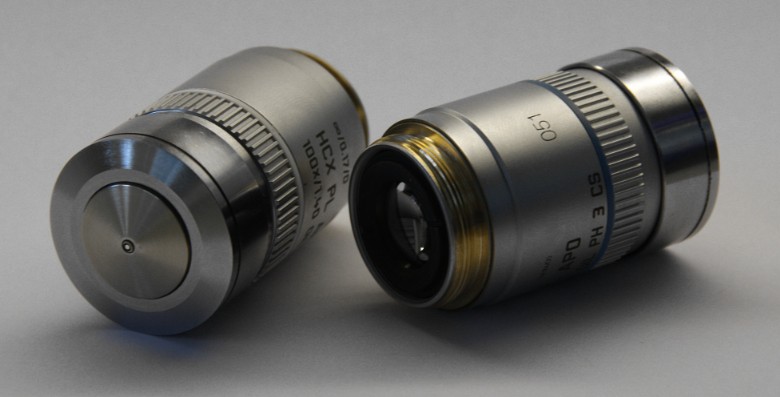![]()
It is necessary to consider the enlargement that we will go to use with the microscope, to get the maximum of the space resolution by this device.
The maximum limit of space resolution in an optic system it is dictated by the diffraction of the light, the equation which follows determines the minimum distance with which it is possible to resolve two objects placed to the distance d:
d = 0.61 x lambda / na
where lambda is the wavelength of the light used in the shoot and na is the aperture number of the microscope
By applying a (minimum) sampling of 2 times (Nyquist), it is possible to apply the following equation to calculate the maximum applicable (theoretical) enlargement for a fixed pixel dimension of the CCD sensor :
M = (2 x pix) / (0.61 x lambda / na)
pix = pixel dimension (mm)
lambda = wavelength ( mm)
Example: Sensor CCD KAF400, wavelength of 515 nm and aperture number 1.3, we obtain:
M = (2 x 9) / (0.61 x 0.515 / 1.3) = 74.48
Example: Sensor CCD KAF261, wavelength of 350 nm and aperture number 1.3, we obtain:
M = (2 x 20) / (0.61 x 0.35 / 1.3) = 243.56
An excessive enlargement, with respect to the theoretical value, produces an oversampling that, translated in the image, assumes the analogous aspect to a not perfect focusing .
![]()
Per ottenere il massimo della risoluzione spaziale con il microscopio bisogna tenere conto dell'ingrandimento che andremo ad utilizzare con questo.
Il limite massimo di risoluzione spaziale in un sistema ottico e' dettato dalla diffrazione della luce, l'equazione che segue determina la minima distanza con cui si possono risolvere due oggetti posti alla distanza d:
d = 0.61 x lambda / na
dove lambda e' la lunghezza d'onda della luce utilizzata nella ripresa ed na e' il numero di apertura del microscopio.
Applicando un campionamento (minimo) di 2 volte (Nyquist) si puo' applicare la seguente equazione per calcolare il massimo ingrandimento applicabile (teorico) data una dimensione di pixel del sensore CCD.
M = (2 x pix) / (0.61 x lambda / na)
pix = dimensione pixel in mm
lambda = lunghezza d'onda in mm
Esempio: Sensore CCD KAF400, lunghezza d'onda 515nm e numero di apertura 1.3 otteniamo:
M = (2 x 9) / (0.61 x 0.515 / 1.3) = 74.48
Esempio: Sensore CCD KAF261, lunghezza d'onda 350nm e numero di apertura 1.3 otteniamo:
M = (2 x 20) / (0.61 x 0.35 / 1.3) = 243.56
Un eccessivo ingrandimento, rispetto al valore teorico, produce un sovracampionamento che tradotto nell'immagine assume l'aspetto analogo ad una non perfetta messa a fuoco.


